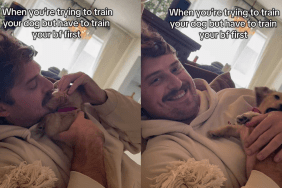Jeff Gellman is the founder of Solid K9 Training, the host of AM radio 790’s What Would Jeff Do?, and a nationally renown speaker. Like many positive reinforcement-based trainers, Gellman believes in exuding a calm, confident energy for one’s dog to mirror. But he also includes physical corrections and no-bark shock collars in his set of training tools. Here at DogTime, we were curious about Gellman’s philosophy and wanted to hear more about his training techniques. Are prong collars an efficient way to train dogs? Is clicker training a fad? Gellman answers our questions with his trademark dynamism.
DogTime: What are the main tenets of your training method?
Jeff Gellman: Defining what the expectations of the pack are using primal, holistic methods of communication. Through unspoken energy, modeling and my stable pack, I am able to communicate with dogs in a way that they understand and respond to much quicker than the faddish clicker trainer methods which I believe will be phased out within the next 10 years as people realize that they don’t work for their dogs.
Every one of my clients that I get has tried clicker/treat training and could not stand it. Meanwhile no one leaves me and goes to clicker/treat training. I give dogs clear signals on what is expected and correct the wrong behavior and continue working with the dog. I surround the dog with great energy from myself and my pack and do not respond to the weakness in the animal. You cannot tell a dog not to be nervous, not to be afraid; what you can do is model the behavior that you are looking for and your dog will understand.
DT: I’m a fan of clicker training; in using such a precise marker, I can let my dog know exactly what he’s doing right. Why do you say it’s a fad?
JG: Being an at-home trainer traveling to my clients’ houses and offices, parks, beaches, and bike paths, I have a deep understanding of what an active dog owner is looking for. They love my training methods, they feel they are far superior to anything they have tried before, and they are amazed at the connection that they have with their dogs that they have never had in the past.
DT: What’s wrong with using positive reinforcement – treats in particular – to train dogs?
JG: It is 100% bribery and takes away the focus of the dogs mind from the trainer. Of course it is great for tricks–roll over, crawl, jump through hoops, etc. None of these things I teach since I do not want my dogs doing those things. I am building a harmonious and holistic bond with my dog.

Why do you think we have three-fourths of the dogs in our country overweight, which shortens their life and increases our vet bills? People have to understand that not using treats does not mean that I don’t use positive reinforcement. All of the dogs that I work with are quite happy. Dogs need a clear defined goal of what is expected and food just does not do that.
DT: So how do you communicate to dogs that they are correctly doing what your are asking of them? In other words, how does the dog know when he gets it right?
JG: Dogs look for strong pack leaders, so just the prescense of one is a HUGE reward, being able to exist with us is praise enough for dogs. I am able to get a deeper bond with my dogs and have my clients get a deeper bond with their dogs with my training methods.
DT: Do you consider your forms of positive reinforcment to be bribery too?
JG: No, i don’t.
DT: Why do you consider prong collars to be an effective training tool?
JG: Firstly prong collars are not choke chains. There is no data that suggests that a prong/pinch collar harms dogs. Flat nylon collars harm more dogs than any other collar and all dogs wear those to hold their dog tags. A properly used pinch collar communicates with the dog in a very effective way in a very fast way what is expected from the dog. I have used them on thousands of dogs and never seen one hurt. Most people who are against them have never used them and are very misinformed. Vets will tell you that they are harmful but they do not know how to train dogs, and if they cared about the health and safety of dogs they would stop selling certain commercial dog food.
DT: Are prong collars appropriate for children to use when walking/training dogs?
JG: 100% yes. Keep in mind that my three- and five-year old daughters train 100-pound dogs with my training system. I would never want my kids to have a bag of treats around dogs, as that would be a HUGE safety issue and would most likely start a dog fight.
DT: Cesar Millan is a polarizing figure in the dog training world. What does he do right and what does he do wrong?
JG: The number one thing that he does for the dog training world is that he gives humans hope that they can fix their dogs, and he then also saves the lives of dogs. What he does not do is train dogs to heel, sit/stay, down/stay, place command and recall training. His message is clear and defined to both humans and dogs and the fact that the APDT is against him means that he is doing something correct since they are responsible for pumping out terrible dog trainers.
DT: What’s the difference between “punishment” and “correction”?
JG: Awesome question. I never punish dogs. They do not understand that, but they do understand corrections. Lets talk about our kids: If we find out that our child stole something from a store, I would sit them down and tell them that stealing is wrong and then go on with my day. That is a correction. If I send my kid to his/her room, that is punishment.
When I work with dogs, I rarely have to verbally communicate with them, I feel strongly that I can communicate with them in unspoken terms out of pack leader respect and a more holistic way. For example, I never use the STAY command. When I tell the a dog to sit, I tell them one time. If they do not do it, I use my two-finger method of gently pushing on their hind quarters in a slow downward movement while holding the leash up to keep their head straight. My three-year-old can do this with a 150-pound dog since we are not using strength but my technique. I expect the dog to stay in the sit/stay position until the dog is released with a command. If the dog breaks command I immediately say NO and put the dog back into the command. I cannot stand people who are constantly saying sit-sit-sit and then stay-stay-stay.
DT: For non-professional dog trainers, “technique” and “strength” can be somewhat indecipherable. Doesn’t that mean a greater chance for human error–and a dog who ends up punished rather than corrected?
JG: Not at all. Most clicker/treat systems encourage bad timing and reward bad behavior.









